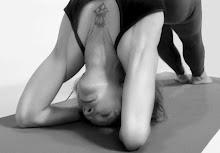Beginning Practice
The key to getting and staying in shape is consistency. One must first make baby steps, make them on a regular basis, and keep making them over and over again until they become a new good habit. Over time, you will see the results. They will not be so dramatic at first, but others will notice. Then you will notice that you feel better, and when you skip too many days you feel worse. This should give you added incentive to keep up a regular practice. Following is a guide for an ultra beginning Surya Namaskara A (sun salutation A) for those who have limited upper body strength. Practice this if you can for six days in a row until it flows easily with your breath and you can do at least 5 in a row without stopping. Then you can lie down and rest for 5 minutes. The entire routine should take about 10 minutes. Ideally, this should be practiced in the morning before you do anything else.
Inhaling, lift your arms up and touch your palms together, looking at your thumbs. Exhaling, fold forward at the hips until you touch the floor alongside your feet. Bend your knees as much as you need to so your back does not round excessively. Keeping your fingers on the floor if you can, inhale and straighten your arms and back (put your hands on your legs if you can't keep your hands on the floor. Be sure not to pinch the back of your neck). Exhaling, place the palms down and step your feet back and slightly apart to a pushup position, then lift your hips up in the air as high as you can. Keep the hands flat and reach your heels down even if they don't touch. This is "downward dog" pose. Relax your neck so you can see your feet, but look at the tip of your nose. Breath deeply in and out five times. If you can, on an inhale breath jump your feet up between your hands (walk up if you are less ambitious!) and straighten your arms and back (the fingertips should stay down, but you can place them on the legs if you are tight in the legs; watch your neck - don't tighten it!). Exhale and fold down. Inhaling, stand up slowly with a straight back lifting the arms up overhead. Exhaling, lower the arms down.
Follow the link for Ashtanga.com on the sidebar to find dvds on the Ashtanga method, or to go to Guruji's website where you can find an active demo of the Surya Namaskar (traditional method). Remember that it takes time to build strength and endurance, so don't do too much on the first day. If you've never done this before, maybe one is enough for a couple of days. If you are sore the next day, don't do any more until the soreness goes away (but don't stop, either). Add only one at a time until you can do five in a row without being sore the next day, and do that six days in a row. Build the good habit.
You will then be ready to add Surya Namaskara B, which adds lunges and two more downward dogs. Or you can add the upward dogs in (without the pushups yet), or start adding the "yoga pushups". If you have been to an Ashtanga class, you have seen those pushups, with the elbows in to the body rather than opening outward. If you are not sure how to perform these correctly, please do not attempt them on your own. Find a class with a qualified teacher who will work with you on proper alignment and technique so you can avoid injuring your shoulders and lower back. The modified version given here will suffice until then.
Namaste, hon!





